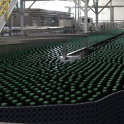|
Docjowles posted:I have a giant 20lb tank and it owns. Probably done about 10 kegged batches and the pressure dial hasn't even moved. The only part that sucks is when I want to bring a keg to a party, hauling around this enormous tank is painful. I have one of those pocket CO2 injectors for road trips and such. It's a bit expensive to push very much beer this way, but it's convenient for the annual Vegas trip, etc. Mine is really old and uses the 12-gram carts, which are way cheaper than the 16 gram carts the newer ones use, but still not really what I would call worth it for heavy use. If I go to a 20-pound bottle, I will keep the 10 as a backup / travel solution. Oh, also... the pressure dial won't move at all until you are virtually out of gas. This is just because of the physical properties of CO2 - it liquifies at comparatively low pressures. This means the pressure will remain essentially constant until there is no more liquid in the tank, at which time the needle will plummet like a rock. Jo3sh fucked around with this message at 19:17 on Oct 21, 2011 |
|
|
|

|
| # ? Apr 24, 2024 11:02 |
|
I'm reading this most recent BYO magazine, and I guess in last months Jamil Zainasheff posted a recipe for a maibock with an OG of 1.070 and recommended a 4 gallon starter. Someone thought it was a mistake and BYO said it wasn't: "It takes a lot of yeast to brew a high-gravity lager.....a 4 gallon yeast starter for a 5 gallon batch of Maibock" This is just Jamil being crazy with yeast again, right? Come on, a 4 gallon starter? More specifically, he said "5 packages of yeast into a 15 liter starter"
|
|
|
|
RiggenBlaque posted:I'm reading this most recent BYO magazine, and I guess in last months Jamil Zainasheff posted a recipe for a maibock with an OG of 1.070 and recommended a 4 gallon starter. Someone thought it was a mistake and BYO said it wasn't: I would imagine so, although I would probably do at least a 1 gallon starter for a lager that size. Ideally I would just repitch onto a cake from a helles or something though. 5 GALLON STARTER!
|
|
|
|
RiggenBlaque posted:I'm reading this most recent BYO magazine, and I guess in last months Jamil Zainasheff posted a recipe for a maibock with an OG of 1.070 and recommended a 4 gallon starter. Someone thought it was a mistake and BYO said it wasn't: Jamil isn't pulling these numbers out of his rear end with no basis, there is a lot of science from PhD's and others on pitching rates for ales/lagers. In George Fix's publication "Principles of Brewing Science" he stated that an optimal pitching rate for healthy beers without defects you are looking at 0.75 million cells per milliliter per degree plato ales, and 1.50 million cells per milliliter per degree plato for lagers. This is for most yeasts that you would want clean fermentations with little-to-no yeast stress related flavors, and a strong vigorous ferment that behaves predictably and finishes reliably. Using this information you can figure out how much yeast you will need to pitch and then you can use the known science on yeast propogation to find out how you get that much yeast. For a 1.070 OG lager you need about 530 billion cells. Without a stir plate that amounts to an ~18 liter starter, or with a stir plate a ~8 liter starter. I didn't read the article but I am guessing he made the assumption that people with stir plates would know how to do the numbers and convert appropriately. I am doing a ~1.085 OG imperial porter this weekend and I'll need about 3L worth of yeast from a stir plate and I want to replenish my yeast bank a little so I made a 3.5L starter. Read this article from MB Raines, Ph.D on yeast propagation techniques and the effect they have on population density. You are basically screwed if you don't have a stir plate. rage-saq fucked around with this message at 20:14 on Oct 21, 2011 |
|
|
|
To be clear I don't actually plan on making that recipe, I just saw the reader comments about it and couldn't believe what I was seeing. I think I'm bothered by the whole thing because, yes, I'm sure there is a lot of science behind it, but there is a difference between things that are achievable on a homebrew scale and things required on a commercial level. With a 4 gallon starter, you're never going to be able to use a stir plate with something like that unless you have multiple stir plates. I feel like if he was just simplifying it for people who don't have stir plates / haven't gotten into yeast starters yet, why didn't he just say something like "you should brew a 1.048 lager with this yeast first, then pitch directly on top it's yeast cake."
|
|
|
|
RiggenBlaque posted:To be clear I don't actually plan on making that recipe, I just saw the reader comments about it and couldn't believe what I was seeing. I think I'm bothered by the whole thing because, yes, I'm sure there is a lot of science behind it, but there is a difference between things that are achievable on a homebrew scale and things required on a commercial level. Who said its not feasible on a homebrew scale? I'm pretty sure any homebrewer who really wanted to brew a 1.070 OG lager would be able to handle all of the requirements above, and if not this would be a good reason to learn. The purpose of his statement worked, people are looking at and thinking about yeast starters more than you were previously, which could have been "not at all". For a big lager you need a shitload of yeast, and so it is more viable to do what you said and brew a small beer first and use all of that yeast. His "4 gallon starter" aka 18 liters was what you would need if you DIDN'T have a stir plate. If you do have a stir plate it would come in at about 6.7 liters, significantly less.
|
|
|
|
I think it is important to get across how important it is to get so much lager yeast, but from the looks of it, lots of people mistook "15 liter starter" for "1.5 liter starter" which is exactly what I would have done had I read that original recipe, especially since BYO makes tons and tons of typos on their recipes. One line like "brewers using stirplates can create a X liter starter instead" or anything like that would clear up the confusion.
|
|
|
|
ifuckedjesus posted:I don't think it will work well. I bet the metal holds up... you could put a grate over it for better support - but I don't think it will heat enough. Too late I bought it from the dude for $35, which is just $5 more than an empty tank cost. It looks like it will easily hold a couple hundred pounds, but I'm worried that the burner itself has a smaller diameter than I expected. I will be trying it out in a couple weeks and if it sucks I'll sell it and just get a cheap burner. Thanks to indigi, jos3h and hypnolobster for your replies as well. I'm honestly not sure how easily or efficiently this will heat up 6 gal of water with the burner being as narrow as is and the pot being as wide as it is.
|
|
|
|
digitalhifi posted:Ideally I would just repitch onto a cake from a helles or something though. 5 GALLON STARTER! That's probably what I would end up doing also - and it's how I seem to end up brewing big ales, too. I don't like to go very many generations, usually about three, but a chain of beers in small, normal, and strong strengths works nicely. My last 1.080+ beer finished in about 3 days on a 3rd generation yeast cake like that.
|
|
|
|
I'm making a red ale this weekend with wyeast 1272 (American Ale II), and I want to reuse the yeast cake for a strong porter. I tried googling, but haven't found much about this yeast being used in a porter. Any reason not to do it?
|
|
|
|
Nope! Go for it.rage-saq posted:Jamil isn't pulling these numbers out of his rear end with no basis, there is a lot of science from PhD's and others on pitching rates for ales/lagers. One weird thing from that White/Jamil Yeast book was a section saying that if you're direct pitching from a fresh order (or vial/pack for homebrewers) of commercial yeast, you only need about half of the cell density usually quoted in recipes cause of the 90%+ viability and something else I forget. That whole bit, I think it was a paragraph at most, seemed contrary to everything Jamil's ever said on the subject, cause you'd think he would have mentioned it somewhere or have an option for that on his yeast calculator. I can't tell if it's in there cause it's true or if it's in there as a concession to White for marketing his product as direct-pitchable while then going on to claim you normally (read: if repitching) need pitching rates way higher than a vial of White Labs contains. I usually go with the sorts of numbers Jamil recommends unless I have a specific reason not to. That said, gently caress a 4 gallon starter, that seems absolutely ridiculous. Again, from that Yeast book, they explicitly state that you start to get rapidly diminishing returns (in terms of yeast growth and propagation) once your starter size increases past 1.8L. There's got to be an easier, more efficient, or cheaper way of growing up that much yeast. tesilential posted:I'm honestly not sure how easily or efficiently this will heat up 6 gal of water with the burner being as narrow as is and the pot being as wide as it is. What's the best way to get my burner to put out less soot? It's only really a problem when I jack it up to 80% or more, but even in the 10 mintues or so I let it rip that high it builds up a nice coating on the bottom of my pot. I've been futzing with the air intake vent thing without much success, but then I have no idea what I'm doing. indigi fucked around with this message at 21:59 on Oct 21, 2011 |
|
|
|
indigi posted:Nope! Go for it. Jamil's yeast pitching calculator has a viability calculator on it. Fresh pitching from a direct order is what most pitching rate estimates are based on. As far as the vials being direct-pitchable that makes the assumption that the beer is a 1.040-1.050 OG 5g batch, which may cover a good portion of the casual homebrewer population. Once again on the 4 gallon starter thats only if you don't have a stir plate. Jamil's website doesn't seem to scale the yield of stir plated starters very well, quickly dropping down to 50 mil/cell per ml, as opposed to the 120-150 mil/cell per ml that isn't difficult to achieve by homebrewers. As far as the "diminishing returns" goes its not a factor of the size of the starter as it is the size of the step, but I'll have to read what the yeast book said to confirm. You need a lag phase (finish fermentation, hibernate, repitch) in the yeast reproduction process when growing to certain scales to allow them to continue to do so healthily.
|
|
|
|
This has been sitting in a carboy for a little over 4 weeks, at a pretty much constant temp of 65F:code:
|
|
|
|
Plastic Jesus posted:This has been sitting in a carboy for a little over 4 weeks, at a pretty much constant temp of 65F: 4 weeks seems like a long time for US-05 even at 64*, what do your gravity readings say?
|
|
|
|
rage-saq posted:Yeast starter poo poo I agree, and this is why I do most lagers with dry yeast, 1-3 packs depending on gravity and it's so easy.
|
|
|
|
Ugh. I bottled a red ale (around 1.06 og, 1.15 fg) two and a half weeks ago. Cracked two open, and they're flat. I don't think I forgot the priming sugar - but maybe I did. Should I wait? Pour them all into a bucket, add some sugar, and try again?
|
|
|
|
wafflesnsegways posted:Pour them all into a bucket, add some sugar, and try again?
|
|
|
|
wafflesnsegways posted:Ugh. I bottled a red ale (around 1.06 og, 1.15 fg) two and a half weeks ago. Cracked two open, and they're flat. I don't think I forgot the priming sugar - but maybe I did. Possibly dumb question but where are they being stored? If they're in the fridge they will take loving forever to carb, stick them in a closet or something where they'll sit above 60. RiggenBlaque posted:4 weeks seems like a long time for US-05 even at 64*, what do your gravity readings say? Seconded. Bubbling "several times a day" is probably just dissolved CO2 in the beer escaping, not real fermentation activity. Take a gravity reading, airlocks are a notoriously terrible indicator. A hydrometer is like $10 and will pay for itself the first time it answers a question about a batch for you.
|
|
|
|
They've been at around 70 degrees, behind my couch. Put the beers in the fridge for a day before I drank them. They're also very, very slightly carbonated, but that's only noticeable if you're really looking for it. There's also some sediment at the bottom of all the bottles, which makes me think the yeast has been up to something, at least. Hmm, now that I think about it, maybe I shouldn't be keeping that bag of lactose next to that bag of dextrose... wafflesnsegways fucked around with this message at 07:26 on Oct 22, 2011 |
|
|
|
Docjowles posted:Seconded. Bubbling "several times a day" is probably just dissolved CO2 in the beer escaping, not real fermentation activity. Take a gravity reading, airlocks are a notoriously terrible indicator. A hydrometer is like $10 and will pay for itself the first time it answers a question about a batch for you. I have a hydrometer, I was just being lazy. I'm also apparently terrible at reading a calendar since it's been in the carboy 3 weeks, not 4. Anyway, current gravity is 1.02 (started at 1.08). Still cloudy and slightly sour, should I let it hang out for another week? Edit: more astringent than sour, but no off aromas. Still, I probably hosed this batch, didn't I? Plastic Jesus fucked around with this message at 08:13 on Oct 22, 2011 |
|
|
|
I am starting a cider brew tomorrow from our apple orchard. I am super stoked. I went to the local home brew place and got all the equipment and I was told 7 days after foam in the primary and thirty days in the secondary, does that sound right? I have seen up to three months mentioned on line.
|
|
|
|
Plastic Jesus posted:Edit: more astringent than sour, but no off aromas. Still, I probably hosed this batch, didn't I? No, time will cure it if it tastes strange. Just relax, do not worry and have a beer you had made yourself.
|
|
|
|
stizu posted:I am starting a cider brew tomorrow from our apple orchard. I am super stoked. I went to the local home brew place and got all the equipment and I was told 7 days after foam in the primary and thirty days in the secondary, does that sound right? I have seen up to three months mentioned on line.
|
|
|
|
I'm cold conditioning a kolsch right now (going on two weeks) and was wondering: If I'm going bottle condition it, will I have a tough time with carbonation?
|
|
|
|
That big oatmeal cookie brown ale from Radical Brewing that got discussed a bit a few pages back sounds like just the thing for a nice autumn beer. I'll probably head to the local shop tomorrow to buy grain and brew it next Sunday or Monday. Maybe I'll add a spice tincture to one of the kegs just for fun.
|
|
|
|
I kind of feel dumb for asking, but does root beer count, or should I go elsewhere? I've found root beer kits on the web, but I'm leery of it, and quite frankly, I'd like input from sources other than the people directly selling it. I'm more or less dissatisfied with the quality of commercial root beer. I once (only once) had it straight from the tap at an A&W shop where it tasted much better. It made me think that (like many other circumstances) what I make at home could be better still. Thanks Brew-Goons
|
|
|
|
Root beer is a tricky thing. It can be as easy as adding root beer extract to sugar water, hopefully you can find an extract that you like, but beyond that there are a ton of possible ingredients, usually including sassafrass and wintergreen. I've never gone beyond using extracts, but here is a decent book with a lot of modern and historical root beer recipes. Brewing for the first time in like 3 months today. I'm making a dry-rear end Amarillo IPA that will hopefully impress my friend from Portland who sucks and is gay. Baby needs his hops, waa waa, Colorado beer is too sweet, change my diaper and finger my butthole. loving hop-heads. Easy peasy, mashed at 150 for 90 minutes or so: 11 lbs. Colorado 2-row (never used this before) 1 lb. Victory malt 1 oz. Amarillo 9.3%AA at 60, 15, 10, 5, 1, and dry hopped. 1000mL day-of starter of WLP001
|
|
|
|
Why not throw the 15,10,5 additions all in at 1 or flameout? Supposedly better aroma and taste that that way. I have a SMaSH MO/cascade that just had a 60 min (39 IBU) and 0 min (3 oz) additions with a planned 2 oz dry hop. Tasted clean and bitter at kegging, will try in a week or so. I brewed a 1.085 RIS mashed around 148 so it will probably dry out a bit more than I wanted. Was going to pitch 2 packets of US05 but at the last second I realized I could just pitch 75% of a 1968 yeast cake from my Fuller's London Porter clone instead. Saved me having to rehydrate us05 and wash the 1968. I did want to keep reusing the 1968, but heard you shouldn't from high gravity beers so I top cropped with a mason jar. Thing is once the bubbles died down there's not much 1968 in the jar so I will probably have to make a starter  . .I usually dont bother with starters as I honestly haven't noticed a big difference. Hell on my SMaSH brew I pitched 5 month old washed yeast from the fridge and got same final gravity (1.01) as I did with a 2L starter and fresh packet the first time around.
|
|
|
|
tesilential posted:I brewed a 1.085 RIS mashed around 148 so it will probably dry out a bit more than I wanted. I would not be so sure. For big beers, you really do need a fermentable wort or you end up with a candy beer. I don't remember exactly, but I did my last RIS at 152 or so, and used a few pounds of candi syrup in it, and it did not come out too crisp. Plus, you're using a less-aggressive yeast with 1968, so I think you'll have plenty of body.
|
|
|
|
Finally got around to brewing a repeat of my really awesome porter I did about a year back. It takes a big page from a baltic porter grist (which is what it originally was supposed to be last time) but uses an awesome british yeast. The only thing I changed on this from the first brew was a different bittering hop as I can't get that anymore. The Profound code:
|
|
|
|
wafflesnsegways posted:Ugh. I bottled a red ale (around 1.06 og, 1.15 fg) two and a half weeks ago. Cracked two open, and they're flat. I don't think I forgot the priming sugar - but maybe I did. Wait, sometimes they take a little while to carb. One thing you can do that may help speed things up is to flip the cases upside down, then after 2-3 days right side up. Repeat until carbonated. This keeps the yeast in suspension and may help get things carbed faster. If you still don't have any carbonation in another two weeks then you may need to take more drastic measures.
|
|
|
|
Does anyone have a super-basic recipe for Apple Cider? I have never done any home-brewing before, but I'd like to give it a try and need some hand-holding. I was originally going to use some spare apples I picked, but I am not sure I have the space to mill/press them in my current apartment (that's a lie, I totally do, I'm just scared since it's my first time As far as equipment, I have only picked up what the fellow at our brewing equipment shop said was necessary for the first ferment. I've got a 6-gallon bucket with little O-ring vent hole in the top (he said it works as a primary for a 5-gallon brew), an S-shaped vent/sterilizer doohickey, and some oxygen-based sanitizer. I've got a friend who has homebrewed beer before who's willing to lend me some other equipment if necessary (probably a secondary? and/or siphons & such?). I also picked up a vial of sweet cider yeast, figured I'd try it instead of the champagne yeast they had. My current plan: 1. Get apple cider. (non-alcoholic. i.e. apple squeezings, if the store sells 'em) 2. Pasteurize cider. 3. Soap & Water to clean out bucket. 4. Rinse bucket with water. 5. Wipe down bucket (& lid, sides, etc) with sanitizer solution. 6. Let bucket air-dry. 7. Pour pasteurized apple juice into bucket. 8. Add yeast. 9. (Stir?) 10. Seal bucket. 11. (Run around like a chicken with no head while I try to figure out how to get sanitizer solution in the S-valve doohickey) 12. Put vent in top of bucket.' 13. Wait, and try not to be scared at random farting noises. 14. Get help for subsequent stages. Things I'm not sure about: does the primary need to be stored at a particular temperature? Our apartment is usually 70-75, depending on time of day and outside temperature, but I can store someplace else if it needs to be warmer. My (limited) understanding of post-primary process: 1. Primary (takes about a week) 2. Sanitize secondary container. 3. Secondary (transfer primary, sans gunk at bottom of bucket, to a 5-6 gallon secondary bucket. Add nothing, just move it over. Re-seal and let sit for a while longer) 4. Wait while secondary secondaries. (a week? or a month?) 5. Sanitize bottles. 6. "prime" bottles. (No idea what this involves - spices? sugar? newt's eyes?) 7. Move cider to bottles. (siphon, I presume) 8. Cap bottles. Where am I making mistakes? What should be added/removed at the secondary stage? What does priming entail? What do you folks recommend, recipe-wise, for a basic but tasty cider? When (if at all) do I add things to make this bubbly?
|
|
|
|
Wow. You're way overthinking that. 1) Acquire juice. I use whatever Costco has on coupon or whatever. As long as it tastes good, it will made drinkable cider. Vitamin C (ascorbic acid) is ok. Sorbates or preservatives are not OK. This is already pasteurized, so there's no need to worry about it. 2) Sanitize your bucket, lid, airlock, and stopper. Star-San is the bomb for this. No-rinse, food grade, super easy to use. Short contact time. Don't fear the foam. I make up a spray bottle and just liberally spray everything down so it's good and wet, let it sit for a few minutes, then dump any liquid that has collected. 3) Pour the juice in the bucket. Because you are using factory-sealed containers of pasteurized juice, no special handling is needed. I just open up the lids and pour it in. 4) (optional) Add additional sugar. This will boost alcohol content and can add flavor. You can add things like white sugar, brown sugar, corn sugar, honey, juice concentrate (again, no sorbates), agave syrup, maple syrup, candi syrup... really, just about anything you can think of will work. If you choose to add sugar, you can add anywhere from 0.25 to 1 pound of sugar per gallon of apple juice, whatever you want. Honey is a nice choice because of its self-sanitizing nature. I have also used sugar straight from a new, unopened bag. If you're not confident the sugar is sanitary, you can boil it up with a little water for a few minutes to sanitize. 5) If you chose to add sugar in step 4, stir well to mix and dissolve with a sanitary spoon. 6) Add the yeast and seal up the bucket. Install your airlock. Fill the airlock with plain water to the line (about halfway up). 7) Leave it alone for a while. I usually let mine go 4 weeks or so. Cider does not ferment as quickly as beer does. Disturb it as little as possible. 8) Package the cider. This is worth a post of its own, but basically, you will add a measured amount of sugar if you wish to carbonate it, siphon it into bottles, and cap them. I use a kegging system, so I just rack it into a keg and hook up the gas line, but you're probably not there yet.
|
|
|
|
A few tips just to add on: If your bucket needs washing, just let it sit with some chlorine free OxyClean and warm water overnight (About half the volume they suggest for laundry is usually good. I use a scoop and a half for a full 6-7 gallons to clean my 5 gallon bucket.) As noted, you only need to pasteurize if you're getting from a farmers market or pressing your own. Also, pasteurize at 155 for like 10 minutes, do not boil. You probably do want to stir after you pitch yeast, especially if you had to pasteurize, since yeasties need air to do the magical voodoo that they do do. I've heard terribly wildly varying opinions on how long Cider should sit.
|
|
|
|
Jo3sh posted:6) Fill the airlock with plain water to the line (about halfway up). I've never made anything but beer, but i put Star San solution in the airlock. Arcturas- To get liquid in your S-shaped airlock, you can just dunk it in liquid and shake. It will fill up. Or if you have a spray bottle you can shoot it in through the top.
|
|
|
|
Bottling 1) Use a priming calculator to determine how much sugar you should use. 2) Weigh out that amount of sugar and put it in a saucepan with a pint or two of water. Boil for a few minutes to sanitize and dissolve. 3) Pour the resulting syrup into a sanitized bucket. Put your caps into a small bowl of sanitizer. 4) Sanitize your racking cane and tubing. Siphon your finished beer or cider into the bucket with the priming syrup. If you curve the hose, it will make the liquid swirl, and will mix everything up. If you just can't bear not to stir it, use a sanitized spoon. 5) Lift the bottling bucket with the primed beer or cider onto the counter. 6) Attach your sanitized bottle filler (a short piece of rigid tubing with a touch valve at the end) to your racking setup and start siphoning into your bottles. Fill the bottles until they are full all the way to the lip; that way, when you remove the bottling wand, you will leave a perfect amount of headspace. 7) Place a sanitized cap on top of the bottle and use your lever capper to seal it. 8) Store the bottles at room temperature for a couple of weeks to allow the carbonation to develop. 9) Serve. Jo3sh fucked around with this message at 01:07 on Oct 24, 2011 |
|
|
|
tesilential posted:I've never made anything but beer, but i put Star San solution in the airlock. I tried that once and the foam that developed seemed to inhibit the flow of gas through the thing. If you don't overfill the airlock, the risk of suckback is essentially nil - and municipal tap water is pretty sanitary anyway. I've heard of people using vodka, too, but it doesn't really seem useful to me.
|
|
|
|
Water? Like from the toilet?
|
|
|
|
I'm no pro - but I used water mixed with starsan for my airlock at first, but it bubbled like crazy & it created these huge soap bubbles that were going everywhere out the top of my airlock. Since then I have used cheap vodka & I don't have to worry about soapy bubbles everywhere. YMMV
|
|
|
|

|
| # ? Apr 24, 2024 11:02 |
|
mewse posted:Water? Like from the toilet? I really am at a loss for words. What?
|
|
|




















